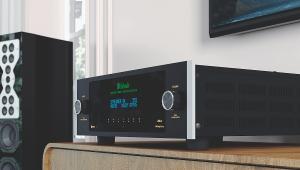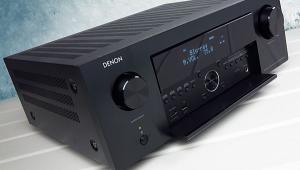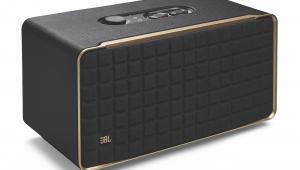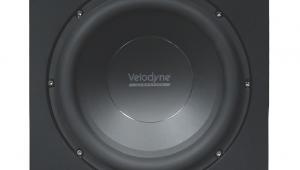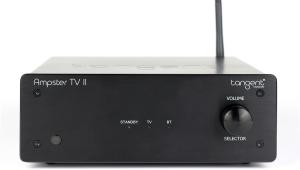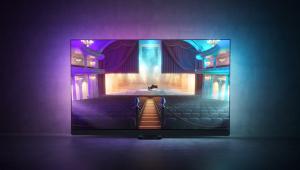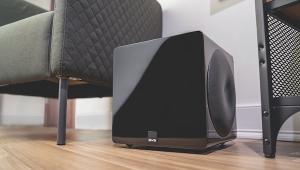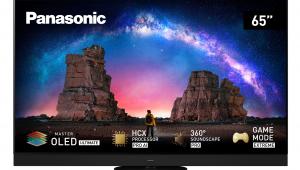Onkyo TX-NR5009 review

Onkyo’s flagship TX-NR5009 receiver is so crammed full of goodies I really don’t know where to start. The big price ticket might put some off, but I reckon it’s spectacularly good value. It has all the high-end goodies, too, such as the massive toroidal transformer, separate power supply for A/V processing and a multi-layer chassis to reduce vibration.
The chipset list reads like a who’s who in AV technology and there are some features you won’t find on rival receivers, including ISF video calibration and 4K video scaling. You won’t be surprised to hear that it sports a shiny, top-of-the-line THX Ultra2 Plus certifi cation, Audyssey’ top-spec MultEQ XT32 EQ system and nine channels of amplification.
The TX-NR500 is a big, heavy beast to wrestle from the box. In the supplied black it has cosmetics somewhere between Knightrider’s KITT car and a small house. The brushed aluminium is lush, the buttons solid and the drop-down flap conceals most of the essential buttonage should one lose the remote control, or indeed any of your Apple OS or Android devices running the Onkyo remote App. Frontmounted USB, HDMI, analogue AV and optical digital inputs rate as the perfect array of front-facing connections. The main volume knob is a bit lightweight in feel, but with all those control options are you ever going to use it anyway?
Connections galoreBack panel connectivity doesn’t match Denon’s mighty A1HD in sheer number terms, but the TX-NR5009 has got it where it counts. The seven HDMI inputs and twin outputs are all 3D and 4K video capable, the analogue connections are goldplated and 11 sets of binding posts cater for every conceivable iteration of speaker configuration. This includes any type of 9.2 using height or width processing right down to vanilla 5.1 in the main room and two separately powered stereo zones.
A 32bit processor handles audio processing, feeding a raft of Burr- Brown 192kHz/32bit DACs for all channels. The Audyssey MultXT32 EQ system can analyse and EQ two subwoofer channels independently, making the unit a 9.2-channel AVR. You get Dynamic Volume and EQ in the Audyssey suite, plus Dolby Volume, which aims to achieve reference sound balance at any volume level.
HQV’s latest Vida chipset has been implemented for core processing duties, backed by a cutting-edge Qdeo scaler, which will take any video input and upscale it to 4096 x 2304 pixels. The Vida processor uses expanded 12bit colour processing and HQV’s StreamClean technology. This aims to cleans up compressed video in real time by eliminating mosquito and block noise from lower quality sources. Tested with some reasonable quality YouTube footage this worked exceptionally well. Obviously, 4K displays are few and far between at present, particularly at my house, so I were unable to test this feature at this time.
Network features have been given a particular buff -up by Onkyo, although there is no on-board wi-fi , which is a bit remiss. Still, the TX-NR5009 is a DLNA-certifi ed machine with direct access to your Spotify, Napster and last.FM accounts. Internet radio is predominantly supplied by vTuner, although those of a brave disposition may want to try the surreal Aupeo! This German-based streaming service sifts music streams by the wildest categories including your mood. Next time you want music that is particularly ‘stressful’, ‘dramatic’ or ‘danceable’, Aupeo! is at your service. Surprisingly, there’s no AirPlay compatibility.
The interface is a multi-paged menu affair that forgoes animation in favour of getting the info across in more detail. Each feature comes with a little explanation at the bottom of the screen and the whole interface is neat and intuitive. The two-way remote control is a little bland, yet easy to navigate, and the Onkyo App is best described as functional. A new App should be launched by the time you are reading this review, which is purportedly going to give Pioneer’s sumptuous iControlAV a run for its money.
Set-up using 7.1 channels as standard, plus height speakers for full-bore 9.1 cinema, took about an hour including the EQ procedure discovering two connection issues with a newly installed cabling loom. Once you have run the Audyssey setup, there is no way of graphically displaying exactly what sort of EQ filtering the system has applied to each speaker. But as the result was pretty spectacular, maybe it’s not such a big issue.
Centred dialogueI turned once again to Star Trek. The opening battle sequence, as the Romulan ship Narada engages the USS Kelvin, is delivered with an explosive power and warp speed. The Onkyo crafts the whole soundstage with a crisp and involving dynamic and dialogue that is supremely well articulated. The height processing perfectly draws the dialogue to centre screen and gives the entire front-end soundstage a tangible three-dimensional presence. I found I had to give the rear effects channels a tweaking of a dB or two just so they were not lost to the epic front of cinema sound.
The scene unfolds with scale and precision, and as the classical score swells above the battle to iterate the inevitable demise of Kirk senior, the Onkyo absolutely nails it. The atmosphere, dialogue and the eff ects all come together in a perfect ballet of sound that conveys a huge emotional climax. I have seen the sequence a dozen times and yet I found the Onkyo’s stellar performance brought tears to my eyes as if it was the first time I saw it.
Skip to the young James T Kirk driving his classic sports car across the Iowa desert and the Onkyo keeps up the pace with aplomb. The rock/ rap soundtrack thunders into the room, but never masks the sound of the car itself. When the car goes over the cliff an explosion of sound eff ects that fill the room, played out in slow-mo just to ensure you hold your breath for a little longer. It is an all-channels festival of sound and if there is any criticism to be levelled at the TX-NR5009 it is a little bit of hardness when all channels are being driven really loud.
The dramatic cut to Spock in the Vulcan academy is thrilling in its dynamic change of pace. Here the Onkyo delivers the size and airiness of the hall with a spacious grace that really paints the atmosphere in detail. Close your eyes and you can be in that high-ceilinged room, and Spock’s voice is conveyed with attention to the smallest inflection or detail as he grows older by the cut-scene. His final line, ‘live long and prosper’ is delivered to the Vulcan command with a faint contempt that lesser AVRs simply fail to capture.
This one’s a keeperWith a few minor caveats, the TX-NR5009 is an outstanding success. It is mind-bogglingly well featured, offers unique functionality and sounds crisply detailed and eloquently dynamic. From a receiver review that I found hard to start, I am left with a performance I find hard to end. Just one more Blu-ray, then.
HCC VERDICT
Onkyo TX-NR5009
Price: £2,700 Approx
Highs: Excellent video processing; features galore; dynamic sound
Lows: No AirPlay or EQ graphic display; slight hardening at very high volume
Performance: 5/5
Design: 5/5
Features: 5/5
Verdict: 5/5
Specifications
Dolby TrueHD: YES and DD Plus, DPL IIz, Dolby Volume
DTS-HD Master Audio: YES and DTS 96/24, Neo:X
THX: YES THX Ultra2 Plus
Multichannel input: YES 7.1 channel
Multichannel output (claimed): 9 x 220W
Multiroom: YES 3 zones
AV inputs: YES 5 x composite; 4 x S-video; 7 x digital audio (4 x optical and 3 x coaxial)
HDMI: YES 8-in 2-out, v1.4
Video upscaling: YES to 4K!
Component video: YES 3-in, 1-out
Dimensions: 435(w) x 463(d) x 198(h) mm
Weight: 25kg
Also featuring: HQV Vida video processing; ISF video calibration; Apple OS and Android control Apps; Bi-amping ability; DSD direct for SACD; powers zone 2/3; anti-vibration chassis; RIHD system control; Audyssey Dynamic EQ; DLNA certified; iPod via USB or optional dock; Ethernet; WMA, AAC, MP3, FLAC, OggVorbis and WAV playback via USB; Audyssey MultEQ XT32 RoomEQ; supplied mic; FM/AM tuner; vTuner, Spotify, Last.fm, Napster; Aupeo!
 |
Home Cinema Choice #351 is on sale now, featuring: Samsung S95D flagship OLED TV; Ascendo loudspeakers; Pioneer VSA-LX805 AV receiver; UST projector roundup; 2024’s summer movies; Conan 4K; and more
|





